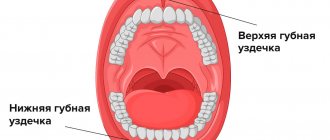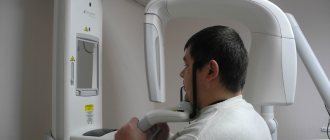Quick transition Treatment of a short frenulum of the tongue
A short frenulum of the tongue (ankyloglossia) is one of the most common minor anomalies in the development of the oral cavity.
The frenulum of the tongue is a fold of the oral mucosa that runs along the midline and connects the floor of the mouth with the lower surface of the tongue.
The function of the tongue frenulum is to fix the tongue to the soft tissues of the oral cavity, preventing tongue retraction (glossoptosis), especially during the neonatal period.
Symptoms
When crying, the tip of the baby's tongue bifurcates in the shape of a stylized heart.
The baby cannot stick his tongue out of his mouth. To test this reflex, you can run your finger over the baby's lips. Normally, the baby sticks his tongue out quite far, moving it around his lips in search of mother's milk.
Breastfeeding takes a lot of time, the baby is capricious, nervous, and clicking sounds are heard when sucking.
The baby is not gaining weight well.
A child with a short frenulum cannot reach the palate with his tongue.
There is a noticeable disturbance in the pronunciation of certain sounds during speech formation.
With a short frenulum (less than 1.5 cm), if it is attached to the soft tissues of the floor of the mouth, functional disorders do not always occur. These include difficulty sucking during breastfeeding and disturbances in sound pronunciation during the formation of phrasal speech.
How is the operation performed?
During a frenuloplasty operation, depending on the type of its structure, the surgeon cuts the fold, excises excess tissue or moves the point of its attachment to the gum. The procedure is performed under local anesthesia, is absolutely painless and lasts no more than 10-15 minutes.
At the IONIKA clinic, doctors are equally proficient in both methods of frenuloplasty - laser and scalpel. Each technique has its own strict indications, its advantages and disadvantages. Despite the fact that laser plastic surgery of the upper lip frenulum has gained the greatest popularity today, we sensibly assess each clinical situation and choose the optimal way to solve the problem based on the patient’s characteristics.
- Laser . This is a minimally invasive method in which a laser beam “dissolves” the frenulum or removes excess tissue, immediately sealing the edges of the wound. The operation is completely bloodless, without the need for stitches, and rehabilitation takes a minimum of time. Laser plastic surgery of the lower lip frenulum is most often used when working with young patients.
- With a scalpel . The classical method is also low-traumatic and is supplemented only by suturing. It is used, as a rule, in cases with a thickened frenulum.
Consequences of frenulum anomaly
Hypotrophy due to impaired sucking, poor weight gain in infants.
Malocclusion, the first signs of which during the period of temporary occlusion is the rotation of the central lower incisors to the lingual side.
Impaired development of the lower jaw, as a result, the formation of a distal bite.
Local gingivitis, periodontitis up to exposure of the roots of the teeth in the area of the lower jaw incisors.
Violation of the pronunciation of sounds that require raising the tongue upward: “sh”, “zh”, “sch”.
Impaired language development due to asymmetrical growth. Low mobility of the tongue impairs the articulation of some sounds. Violation of diction (clarity, intelligibility of pronunciation).
Upper lip frenuloplasty
Plastic surgery of the frenulum of the upper lip is a surgical intervention to trim the frenulum, performed on the patient if there are appropriate indications in the direction of an orthodontist or speech therapist. The frenulum of the lip is a special fold of the oral mucosa, which is responsible for additional attachment of the upper lip to the jaw bones.
In its normal position, the frenulum is woven into the gum at approximately a distance of 0.5-0.8 cm from the necks of the anterior incisors. With a lower attachment or when the frenulum of the lip extends beyond the front incisors and the attachment point is not visible at all, it is considered short. In such cases, it begins in the middle part of the upper lip and is attached approximately 0.4-0.6 cm above the gum, in the area of the gap between the front incisors (diastema).
A short frenulum is easily detected by visual inspection. To do this, you just need to retract the upper lip and examine the place where the mucous cord is woven.
When the frenulum is in a normal position, it does not have a negative effect on health and does not interfere with speech. A shortened frenulum can cause the development of a number of disorders. To correct it, an operation to plasticize the frenulum of the upper lip is performed.
Need for surgery
Most parents have a rather vague idea of the functions of the frenulum of the upper lip and its role in the normal functioning of the dental system. Therefore, when a specialist talks about the need for plastic surgery, many do not understand the importance of it. In reality, the problem must be resolved in a timely manner to avoid unpleasant medical and aesthetic consequences. It is the presence of the frenulum that allows you to correctly articulate, move your lips, open and close your mouth. With its defects (too short frenulum, its improper fastening), the mobility of the lips is significantly reduced, their functioning is disrupted, and various aesthetic defects develop.
The presence of such an anomaly leads to a number of consequences:
- Limited sucking function in newborns. Since in infants the upper lip, together with the tongue, takes an active part in sucking, impaired mobility becomes an obstacle to the process of breastfeeding. In some cases, a neonatologist can independently trim the frenulum of the upper lip.
- Impaired speech formation and correct sound pronunciation. With a shortened frenulum of the upper lip, as a rule, difficulties arise when pronouncing labial sounds, vowels (“o”, “u”, etc.). In this case, the speech therapist recommends plastic surgery, after which the diction is automatically corrected.
- At an older age, due to frenulum defects, bite and chewing functions may be impaired, resulting in digestive problems.
- The shortened frenulum of the lip, as well as its close attachment to the edge of the alveolar process, causes retraction of the interdental papillae of the gums in the space between the incisors. As a result, a gap is formed in the bone tissue between the sockets of the teeth - a diastema. In addition, the distance between the crowns increases.
- A short frenulum pulls back the gums and leads to the formation of a gum pocket, the deposition of tartar and the development of an inflammatory process in the gums.
- The consequences of defects in the frenulum of the upper lip can be instability of the teeth, exposure of their roots, and increased sensitivity. Plastic surgery allows you to avoid the development of a number of dental diseases.
- A frenulum that is too wide leads to regular accumulation of food debris and the formation of plaque.
- Surgery to correct the frenulum of the upper lip is necessary for the prevention of periodontal diseases and inflammatory processes in the oral cavity.
Indications
Medical intervention of any type must certainly be justified. A simple statement of the fact of the presence of a shortened frenulum is not an indication for emergency surgery. Plastic surgery to correct the frenulum is performed in the following cases:
- If there is a diastema (gap) between the central incisors. The frenulum of the upper lip, woven into the interdental papilla and forming a thick cord, prevents the incisors from converging towards the center. In addition, exposure to a small constant load leads to a gradual increase in the diastema and displacement of the teeth forward and to the sides from the center, as well as the development of periodontitis due to constant injury to the interdental papilla.
- In preparation for orthodontic therapy. Soft tissue cords located in the oral cavity, including the frenulum of the upper lip, exert a certain load on the dentition and influence the formation of the bite. If bite correction procedures are prescribed (installation of plates or braces), you also need to pay attention to the correct attachment of the upper lip frenulum.
- If you have periodontal diseases and are at increased risk of their occurrence. In these cases, the short frenulum seems to “pull” the mucous membrane from the base of the teeth, which leads to gum recession - raising its edge and exposing the roots of the teeth.
- In preparation for removable prosthetics. If the installation of dentures is planned, then it is first necessary to perform plastic surgery of the frenulum of the upper lip, since a shortened frenulum will provoke the shedding of the dentures.
- In case of impaired sound production and other speech therapy problems (as a rule, this indication is less common than others).
Optimal time for the procedure
Although plastic surgery of the upper lip frenulum is a minor operation and does not lead to any consequences, it is performed extremely rarely on infants - only when there is a significant disruption of the breastfeeding process
The optimal age is over 5 years. This is a period of active change of bite, loss of milk teeth and eruption of permanent teeth, when the central teeth have erupted by at least 1/3, and the lateral ones have not yet appeared. Carrying out plastic surgery at this stage will help avoid the formation of a gap and will help the central incisors move towards the center (the erupting lateral incisors will also help with this).
Some experts recommend correction of the upper lip frenulum at 7-8 years of age, when the four upper incisors have already fully erupted. If indicated, the operation is also performed in adolescence and older age.
Contraindications
Surgery to correct the frenulum is not performed in the presence of the following conditions and diseases:
- recurrent diseases of the oral mucosa;
- Smile before and after frenuloplasty
- osteomyelitis;
- multiple caries with complications;
- radiation irradiation of the head and neck area.
Of the general contraindications, it should be noted:
- cerebral lesions;
- dysmorphophobia;
- alcohol abuse;
- mental illness;
- blood diseases (leukemia, hemophilia);
- infectious diseases in the acute stage;
- chronic diseases;
- oncological diseases;
- collagenosis, tendency to form keloid scars.
Preparing for surgery
No special preparation is required for the procedure. The oral cavity should be sanitized, since the presence of a source of infection can lead to the development of complications. Some specialists prescribe tests and fluorography, but there is no particular need for them: plastic surgery of the frenulum of the upper lip is a low-traumatic operation.
The only recommendation is to pre-feed the child, since in a hungry state it is more difficult for him to tolerate the procedure. In addition, hunger can affect blood clotting.
Types of operations and their essence
One of the main conditions for a successful operation: the baby must sit in a chair in a calm state for at least 15 minutes. Plastic surgery is performed using various methods. The choice of a specific method depends on the structure and attachment of the frenulum of the upper lip.
- Frenotomy, or dissection of the frenulum. Its implementation is indicated in cases where the frenulum of the upper lip is too narrow, has the appearance of a transparent film and does not have points of attachment to the edge of the alveolar process. The dissection is carried out in the transverse direction, and suturing is carried out in the longitudinal direction.
- Frenectomy, or excision of the frenulum. Prescribed for wide frenulum of the upper lip. The incision is made along the crest of the tense frenulum, and the interdental papilla and tissues located in the bone space between the root parts of the spread central incisors are excised.
- Frenuloplasty – its essence is to move the attachment site of the frenulum of the upper lip. Currently, two types of frenuloplasty are performed.
Y-shaped frenuloplasty
After local anesthesia, the fixed frenulum is excised with a scalpel or special gum scissors. As a result of excision, a diamond-shaped defect remains on the mucosa. In order to mobilize the edge of the mucosa adjacent to the incision, it is trimmed and, using a thin rasp, moved along the periosteum in the apical direction (deep into the formed vestibule). Inside the vestibule, the mobilized mucous membrane is fixed with an interrupted suture to the periosteum. The wound is sutured tightly.
Z-shaped frenuloplasty (according to Limberg)
Infiltration anesthesia is performed, after which a vertical incision is made in the middle of the frenulum. Two oblique cuts are made in opposite directions from it at an angle of 60 to 85 degrees. The formed triangular flaps are mobilized and then fixed so that the central incision is located horizontally. It is very important to properly prepare the receiving bed: if the edges of the incisions are simply sutured together within the mucosa, you can only achieve a weakening of the tension, but it will not be possible to completely eliminate it. Ignoring this point leads to a significant decrease in the effectiveness of the procedure and, as a consequence, the not very popular popularity of this technique. The receiving bed is prepared in the same way as for Y-shaped frenuloplasty of the frenulum of the upper lip. The submucosal tissues are peeled off along the periosteum using a rasp, after which interrupted catgut sutures are applied to close the horizontal incision, while the flaps are fixed to the periosteum.
All of the above operations for plastic surgery of the upper lip frenulum are performed on an outpatient basis, under local infiltration anesthesia. For pain relief, Ultracan D-S forte containing epinephrine (1:100000 in 1.7 ml) is used.
Absorbable suture material is used to close the wounds, so they do not need to be removed later. The entire procedure takes approximately 15 minutes. According to reviews, it is completely painless and does not even cause discomfort.
Laser plastic surgery
Lately, plastic surgery of the upper lip frenulum using a laser has become very popular. The whole procedure takes only a few minutes.
Local anesthesia is first performed using a special gel, after which the light guide of a laser device is directed to the frenulum, forming a focused beam of light. Under its action, the frenulum “dissolves”. The laser also sterilizes and seals the edges of wounds.
Advantages of the method:
- absence of vibrations and unnecessary sounds that frighten children;
- bloodlessness;
- no need for stitches;
- eliminating the possibility of infection from surgical instruments by sealing the edges of wounds with a laser;
- reducing the time of surgery for plastic surgery of the upper lip frenulum;
- absence of pain and postoperative scars;
- short rehabilitation period.
Postoperative care
As a rule, the period after plastic surgery of the upper lip frenulum is quite calm. Minor pain may occur after the anesthetic wears off. Rules to follow at this time:
- Perform thorough oral hygiene daily.
- Avoid hot and solid foods for 2 days.
- Go through a post-operative examination (on the second or third day).
For older patients, special myogymnastics is recommended - exercises to strengthen facial and chewing muscles.
Over a certain period of time after frenuloplasty, one becomes accustomed to the freer movements of the tongue. Diction changes almost immediately after the correction. To eliminate the gap between the teeth (if it has already formed) it takes a little longer, and in some cases additional dental treatment is necessary.
The rehabilitation period lasts no more than 4-5 days. During this time, all unpleasant sensations disappear, and the wounds are completely healed.
Contraindications for surgery
There are practically no contraindications for laser excision of the labial frenulum compared to other operations. The procedure can be performed even on children as young as 6 years old.
Parents should know that laser lip frenuloplasty is the least traumatic and uncomplicated operation that can solve many problems that a child may encounter in adulthood.
Despite this, there are a small number of contraindications, including: - The patient has cancer; — Severe mental and neurological diseases; — Serious defects in the structure of the oral cavity; — Blood diseases; — Infectious diseases in the acute stage; — Advanced caries; - Osteomelit.
As you can see, contraindications are quite serious diseases that are rare. But it should be remembered that a referral for this operation, like any other, can only be given by a qualified dentist after an in-person consultation with the patient.
Postoperative period
The rehabilitation period also goes smoothly. There is no doubt that some pain may occur at the surgical site when the effects of the pain medications wear off.
In the postoperative period, you need to adhere to the following golden rules:
- carefully carry out oral hygiene;
- the first two days after the intervention, do not eat hot and rough foods (nuts, carrots, apples, etc.);
- one day after the operation, visit the surgeon for a follow-up examination.
The sutures in the classical method of operation are not removed, because surgeons use catgut - a suture material that is characterized by self-resorption. The patient may experience minor discomfort at first as he adapts to the ability to move his tongue more freely, but his speech improves very quickly. After a few days, you can perform myogymnastics ─ special exercises that help strengthen the facial and chewing muscles. Children love to make faces, and a dose of positive emotions won’t hurt adults either. By fulfilling all these conditions, the child will not encounter any complications in the postoperative period. In addition, such an operation goes almost unnoticed, and the results obtained will prevent many problems in the future.
In what cases is it necessary to trim the bridle?
The operation of cutting the frenulum of the tongue is called frenulotomy . It is classified as simple and requires only local anesthesia.
Heavy bleeding during frenulotomy is very rare; after a couple of hours the child will be able to return to the usual rhythm of life.
If a short frenulum interferes with the newborn baby's ability to receive nutrition, it must be trimmed. The decision about surgery is made by a pediatric neonatologist.
For infants, as a rule, the operation is performed without anesthesia, since only the sublingual film of connective tissue is dissected, which has practically no blood vessels or nerve endings.
For children aged 3-5 years, surgery to cut the frenulum is performed under local anesthesia. The dentist decides whether surgery is necessary, and the speech therapist prescribes the referral.
Before the operation, the child needs to donate blood for a detailed analysis, which will display numerous indicators, including the number of platelets and the rate of blood clotting.
Surgical intervention is performed provided that the pathology is moderate or severe with limited tongue mobility. After surgery, speech therapy sessions are necessary.
There are a number of indications for frenulotomy, and limited tongue mobility is not the only one. The formation of malocclusion in a child, displacement and disturbances in the formation of the dentition, low effectiveness of speech therapy and articulation gymnastics, as well as the need to install dental implants or orthodontic structures for the child.
Pathology of the tongue frenulum does not always require surgical intervention. If the child does not experience any discomfort during breastfeeding, and his pronunciation of sounds is satisfactory, then it is likely that a speech therapist will help solve the problem. In this case, the child attends special classes, performs speech therapy exercises, articulation gymnastics, etc.
Post-operative care
The rehabilitation period takes one to two weeks. To avoid complications, you must follow your doctor's recommendations:
- monitor the hygiene of the oral mucosa and perform procedures prescribed by a specialist;
- exclude hot, sour and solid foods;
- undergo a follow-up examination with the surgeon who performed the operation;
- do gymnastics to strengthen the chewing muscles.
The above rules will help you return to your normal lifestyle in a short time and prevent deterioration in your health after lip frenuloplasty.
At what age is the procedure performed for children?
In children, pathologies of the lower lip frenulum can cause various negative medical and aesthetic consequences. Therefore, if a doctor finds a defect during a routine examination and recommends plastic surgery, it is better to take his advice.
Dentists believe that the best age for frenulum correction in children is from 5 to 8 years. It is during this period that temporary teeth are replaced with permanent ones, so it is important that the frenulum does not disrupt the correct development of the molar units.
If there are indications, plastic surgery of the lower lip frenulum can be performed in adolescents or adults. For infants, this operation is prescribed only if there are serious problems, for example, the inability to fully feed on breast milk.
Why is a short frenulum dangerous?
A short frenulum is a congenital pathology in which the development and functionality of the ligamentous connection between the tongue and the lower jaw is disrupted. At the same time, the mobility of the tongue in the oral cavity is limited so much that it causes speech problems in the child.
Problems with the frenulum of the tongue in a child can occur in two ways. Young children who are breastfed or bottle-fed and have this pathology may have problems with sucking. This occurs due to the fact that the frenulum of the tongue is so short that it simply does not allow the tongue to function adequately.
With a short frenulum of the tongue, the baby cannot be fully breastfed, due to the fact that it is difficult for him to suck out a sufficient amount of breast milk. Therefore, in this case, immediately after the birth of the baby, he has real difficulties with feeding.
The second option for realizing the problem associated with a pathological frenulum of the tongue is speech defects and they arise much later. Partial immobility of the tongue leads to the fact that the child is not able to pronounce certain sounds correctly; his speech remains similar to babbling, “lisping.”









